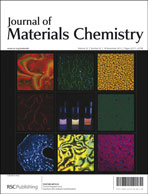A novel functional conducting polymer: synthesis and application to biomolecule immobilization†
Abstract
A recently synthesized conducting polymer poly(TBT6–NH2); poly(6-(4,7-di(thiophen-2-yl)-2H-benzo[d][1,2,3]triazol-2-yl)hexan-1-amine) was utilized as a matrix for biomolecule immobilization. After successful electrochemical deposition the polymer poly(TBT6–NH2) on the graphite electrodes, immobilization of choline oxidase (ChO) was carried out. Due to the free amino functional groups of the polymeric structure, ChO molecules were successfully immobilized onto the polymer surface via covalent binding. For this, glutaraldehyde (GA) was used as crosslinker and bifunctional agent. Hence, a robust binding between the support and the protein molecules was achieved. Scanning electron microscopy (SEM) and X-ray photoelectron spectroscopy (XPS) were used to monitor the surface morphologies of both the polymer and the bioactive layer and to confirm the binding of the protein. Amperometric measurements were recorded by monitoring oxygen consumption in the presence of choline as the substrate at −0.7 V. The optimized biosensor showed a very good linearity between 0.1 and 10 mM with a 7 s response time and a detection limit (LOD) of 16.8 μM to choline. Also, kinetic parameters, operational and storage stabilities were determined. Finally, designed system was applied for pesticide detection.


 Please wait while we load your content...
Please wait while we load your content...